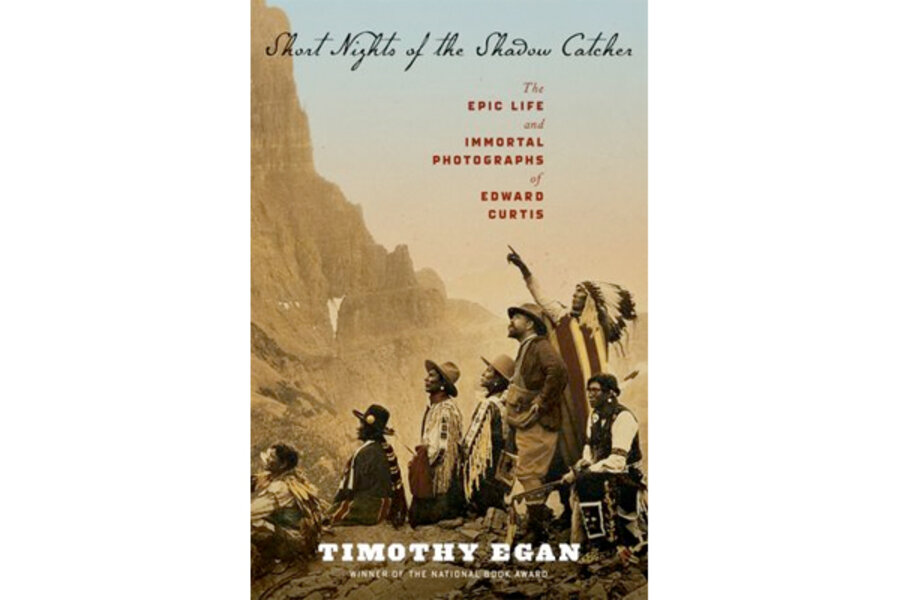Short Nights of the Shadow Catcher
Loading...
Edward Curtis led a life that would make for implausible fiction. He parlayed a sixth-grade education, a hardscrabble childhood, and boundless ambition into fame and quasi-destitution, simultaneously. At the peak of his success – as he supped with President Teddy Roosevelt and photographed his children, played Carnegie Hall, and convinced J.P. Morgan to be his patron – Curtis was living hand-to-mouth. The banker would pay for some of his expenses, but not a penny in salary.
And virtually every cent of his and Morgan’s went to The Cause: documenting – celebrating is probably a better word – the lives and cultures of Native Americans. He accomplished this not simply with his evocative photographs. He also did it in compelling prose, through audio recordings of fading languages, and by using a new medium: moving pictures. These were not potshots. Curtis had to gain the trust of his subjects, who, unsurprisingly, were exceedingly wary of white people in the early years of the 20th century.
Curtis lived with and often like the people he captured on film. He was at home in the wilderness, could travel great distances and endure frequent privations. He dodged eternity now and again, often with his children in tow. In a Hopi snake ceremony, a hissing rattler was gingerly draped about his shoulders.
Curtis saw himself in a mad race to photograph the First Americans before the American Century crushed their spirit and steamrolled their traditional ways. In the argot of the era, as well as in the caption of one of Curtis’ most famous photographs, Indians were a “Vanishing Race,” drowning in the melting pot. Indeed, such was the intent of the federal government, which criminalized Native religious ceremonies and sought to separate Indians from their culture and communal lands. Often, both Curtis and his photographic subjects were breaking the law.
Timothy Egan, a Pulitzer Prize-winning author and New York Times writer, seems to have gone to school on his subject to write Short Nights of the Shadow Catcher: The Epic Life and Immortal Photographs of Edward Curtis. The ungainly title of his seventh book notwithstanding, the author artfully frames a stunning portrait of Edward Curtis that captures every patina of his glory, brilliance, and pathos.
Curtis’ greatest legacy is his 20-volume opus titled "The North American Indian," which depicts dozens of Indian tribes from Oklahoma to the Pacific coast, from the Great Plains to remote Alaskan islands where bureaucrats and missionaries dared not tread. This Herculean task consumed Curtis for more than three decades. It also divided his family, destroyed his marriage, dissolved friendships, degraded his health, and left him without ownership of his own photographs.
The gain for all that pain, however, was truly remarkable. Using his camera, he painted a vivid and romantic portrait of the former masters of a continent as no mere ethnographer, academic, or Hollywood director ever could. Each photograph is a mini-volume unto itself: artful, arresting, and the embodiment of a larger story. Academics argued, then and now, that Curtis wasn’t interested in documenting the reality of Indian life in the 20th century. He used props, seldom worn regalia, and staged atavistic scenes for dramatic effect. All true and beside the point.
Curtis was an artist, not simply a photographer or ethnologist. He would show the world what remained of a people and their culture rather than what had been lost. He wanted Americans to admire his subjects as he did. The viewer, like the reader of a compelling novel, is expected to know that artistic creation is at play in search of a larger truth.
From Curtis’ art and artifice emerged images that are stark, defiant, dignified, heartening, and poignant. You cannot look at his portraits without acknowledging the humanity of his subjects. Here are the people we have defeated, defrauded, and shunted aside. Look at Angeline, who was the daughter of Chief Seattle and who plied the mudflats of the city named after him. She was one of Curtis’ first Native subjects in 1898. Her face is lined with unimaginable cares and unbowed determination. Her very existence is a challenge to the viewer.
Egan, who writes with passion and grace, points out the irony of the Vanishing Race thesis. It wasn’t the Indians who disappeared – far from it. It was instead "The North American Indian" and its creator that vanished. Curtis finished his final volume in 1930 as the Great Depression was deepening and Indians were the last thing on people’s minds. A complete set cost $3,000 (the equivalent of $40,000 today). King George of England ordered a copy and Carnegie and his lot, but sales didn't come easy. If you wanted to see Indians, you could go to the movies for the cheap Hollywood version.
Curtis – who died in 1952 – and his photographs were largely forgotten for the last two decades of his life. His masterpieces would not be rediscovered for another 20 years, in the 1970s, languishing in a bookshop and a museum in Massachusetts. His work has since been celebrated and exhibited again and commercial reprints are widely available. A complete set of "The North American Indian" sold for $1.8 million in 2009.
More significant is that tribes today are making use of Curtis’s photographic and ethnographic work to learn, teach, and inspire. The Hopi, for example, purchased an original edition of Volume XII, which is devoted to the tribe and contains valuable information on their history, language, songs, and traditions. It is hard to put a price on that.
David Holahan is a regular contributor to the Monitor's Books section.








